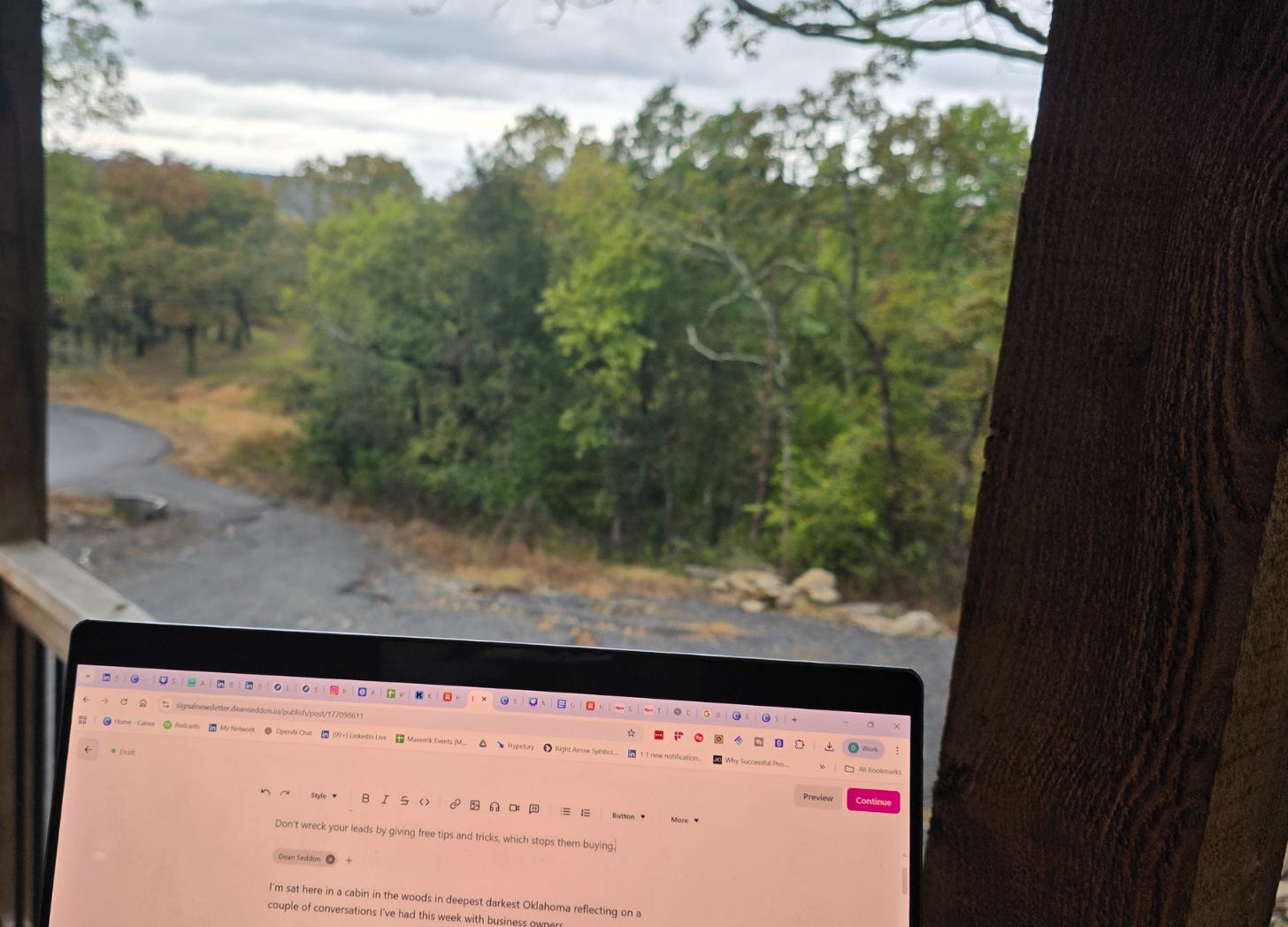Never Do This on Sales Calls If You Want Clients to Buy
Most people think this move proves their value. In reality, it kills the sale.
I’m sat here in a cabin in the woods in deepest darkest Oklahoma reflecting on a couple of conversations I’ve had this week with business owners.
Weirdly, this issue comes up a lot.
I struggle to close leads on sales calls.
I chatted with two people this week who told me a chunk of their work comes from referrals and they close them fine.
But when it’s a lead from social media they struggle to close them.
They slip into training mode.
Sharing tips and tricks.
This is common if you’ve had a lot of referrals.
It’s different selling to someone who has had someone recommend you - they’re pre-sold leads. Referrals come on the call already half sold.
Closing a referral is easy.
Whereas social media leads… they need more focus.
The Education Trap
There’s a common myth:
“If I give them a teaser or free value, they’ll think, Wow, that was amazing, imagine how good the full programme must be.”
But that’s not what happens.
They think, Wow, that was amazing, I can use that right now. I don’t need to buy yet.
That’s why many fall into the training or coaching trap.
It’s easy to fall into this trap.
You get on a sales call, someone shares a challenge, and before you know it you’re giving advice, tools, or even a mini training.
It feels helpful.
It feels generous.
And you think it shows how valuable you are.
But in reality it’s costing you sales.
Giving people tips, tricks or trying to solve the problem will stop them buying.
Because when you educate on a sales call, you hand over a quick fix.
Something they can try themselves.
And once they’ve got that, the urgency to hire you disappears.
Education satisfies.
It doesn’t sell.
Your prospect walks away thinking, That was useful, I’ll try that first.
And they delay buying.
Most people don’t need another free tip.
What they need is clarity.
They need to understand the real problem - what’s behind it, what it’s costing them, and why it matters.
That clarity doesn’t come from coaching or training.
It comes from diagnosis.
Educating vs Diagnosing
Here’s the critical difference:
Educating = trying to solve the problem.
Sharing techniques, steps, or tools. They leave with homework.Diagnosing = helping them understand the problem better.
Exploring what’s happening, what impact it’s having, and how it feels. They leave with clarity that sticks.
Charles Kettering summed it up:
“A problem well-stated is a problem half-solved.”
When someone truly sees the depth of their problem, they realise they can’t patch it with a quick tip.
They see they need a proper solution.
Someone says, “I just need to manage my time better.” If you hand over a time-blocking trick, they’ll leave with a tactic. If you dig into what lack of time is costing them - missed deadlines, constant stress, lack of progress - they’ll see the problem runs deeper.
Someone says, “I just need more confidence.” If you give them a breathing exercise, they’ll walk away with a tool. If you ask when it shows up, how it affects decisions, and how long it’s been going on, they’ll see it’s a pattern that needs addressing at the root.
Someone says, “I just need to get more organised.” If you suggest a productivity app, they’ll try it on their own. If you explore the consequences of disorganisation - errors, wasted effort, frustration - they’ll recognise it’s more than an app can fix.
See the difference?
One gives a quick step.
The other creates clarity.
A Simple Diagnosis Framework
Use this structure to keep yourself out of teacher mode.
Think of it as building a PIER:
P – Problem
Explore the problem as they see and feel it. Don’t correct them. Let them put it in their words.I – Implications
What’s the ripple effect? What’s it costing them? What opportunities are they missing?E – Emotions
How does it feel - frustrating, exhausting, overwhelming? Get them to name it.R – Recommendation
Once the problem, implications, and emotions are clear, then recommend your approach. Not a step-by-step plan - just the treatment path and why it addresses what they’ve described.
This keeps you diagnosing, not delivering.
Why Diagnosis Works
When you diagnose instead of teach:
You protect your expertise.
They can’t DIY it because you haven’t given them tactics. You’ve revealed gaps.You build urgency.
They see the cost of staying stuck. That drives decisions.You position yourself as the authority.
Experts diagnose before they prescribe. Trainers hand out tips. Which one gets hired?
If you naturally help people, this will feel uncomfortable at first. You’ll want to jump in with answers.
Catch yourself.
Ask: am I solving, or am I diagnosing?
When in doubt, ask another question. Go deeper. Reflect back what you’ve heard.
Then, when the picture is clear, recommend, not train.
The goal of a sales call isn’t to prove how much you know.
It’s to help someone see their problem so clearly they can’t ignore it.
Stop handing out quick fixes.
Start diagnosing.
That’s how you move from “helpful conversation” to “paying client.”
Next steps you can take...
Win clients on LinkedIn in 30-mins per day - Check out the Accelerator
Follow me on LinkedIn - Ask me anything on LinkedIn



